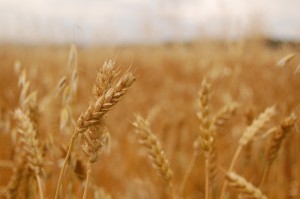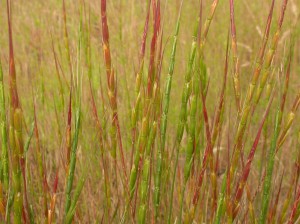GMO Wheat Discovery: Dangers and Implications
 The discovery of genetically modified (GM) wheat in Oregon1 is a wake-up call for those who worry about potential GM contamination of organic crops. The idea of contamination has been an area of concern since GM crops were first introduced, especially when unapproved strains are involved.
The discovery of genetically modified (GM) wheat in Oregon1 is a wake-up call for those who worry about potential GM contamination of organic crops. The idea of contamination has been an area of concern since GM crops were first introduced, especially when unapproved strains are involved.
The escape of unapproved GM wheat is not the first instance where unapproved GM strains have contaminated crops. In 2000, taco shells were recalled due to contamination with StarLink corn2. Then, in 2007, there was contamination of the long-grain rice variety Clearfield 1313 with unapproved GM genetic material. The implications of these events were huge, and the repercussions of the GM wheat could be even more severe. Because the GM wheat was found growing outside conventional plots, it is impossible to predict the extent to which the GM trait has spread without extensive testing.
If contamination proves to be widespread, it could be economically disastrous for organic and conventional farmers alike, and there is no legal framework in place for damage compensation of unapproved GM contamination. Additionally, this type of unexpected gene flow could compromise the integrity of breeding lines, potentially threatening national wheat germplasm collections. There are many research questions that need to be addressed. If left unanswered, GM contamination could spread to the point where our food security is at risk.
How did this happen?
No one seems able to answer how the GM wheat escaped from the test plots. Controlling gene flow is notoriously difficult, and there are many mechanisms that spread genes. For example, male plant genetic material is spread through pollen. Pollen can be dispersed through a variety of vectors—such as wind (in the case of wheat) or insects. Seed dispersal also spreads genetic material and can happen at both long and short distances. Short-distance seed dispersal mechanisms, such as explosive mechanisms (This is no joke! Check out this video of a jewelweed seed pod exploding4) can carry seeds several feet from the parent plant, while other mechanisms, such as wind and animal vectors, can result in long-distance dispersal. Seeds can also get spread by humans. If you ever get a seed stuck in your sock or wedged into the tread of your boot, you may be spreading a plant’s genetic material!
How can we prevent gene flow?
Preventing gene flow is extremely difficult. As a graduate student I worked on gene flow among lupine populations (sky lupines, to be specific5). One of my studies involved preventing gene flow among populations that I planted in a common garden, which proved to be some of the most time-consuming work I have ever done. The trick was that plants need pollen to create seeds, but if you let natural vectors pollinate the plants (such as bees or wind), there is no way to keep the pollen within a designated area. I ended up covering each plant with a plastic bag to prevent bees from visiting the lupine flowers. I then collected pollen in a tiny vial and used a paint brush to hand-pollinate each flower with the population-specific pollen of my choosing. Finally, I used micro-perforated bags to catch all the seeds from each plant to ensure no genetic material would be spread in future generations. The process took me several weeks, and I was only working with a hundred plants!
Obviously, this is not feasible for agricultural systems. Unfortunately, short of growing all GM crops in a greenhouse, there is very little one can do to ensure complete containment of GM genes. Conventional growers should take steps to improve containment of their genetic material, such as implementing buffers between conventional and organic fields, but some gene flow will likely happen regardless of containment efforts.
Next steps
Since full containment of plant genes is difficult, we must focus on ways to preserve the identity of our wheat varieties and determine the extent to which the GM genetic material has entered the supply chain. To do this, research must determine contamination spread distance, wheat varietal integrity, and weed contamination possibility.
Wheat is pollinated via wind, and viable pollen can travel over 60 meters from the source plant6. Examining the distances at which GM and non-GM wheat could form hybrids, one study in Spain found that hybrids could still be found7 even at their largest examined distance (100 meters). This highlights the need for testing to determine how far the contamination has traveled. If the presence of GM genetic material is limited to a small area, it will be easier to contain. First, however, we need to know if the escape of GM wheat is an isolated event or if it has occurred around test areas outside Oregon, and how far the genes have traveled.
All wheat varieties should be tested, so that we can understand which varieties may have crossed with the GM wheat. Some varieties are more likely to outcross than others due to their flower structure, how tightly flowers are clumped together in the inflorescence, the amount of time their flowers are open, and how far their anthers (the part of plant where pollen is stored) extrude. If crossing has occurred, we are in danger of losing the integrity of our breeding lines. This is especially important when it comes to seed production. If contaminated varieties have been used as seed production plants, the germplasm of entire varieties may be compromised. Additionally, since testing of GM wheat started over a decade ago, we need to test national seed banks to ensure that GM material has not contaminated stored germplasm.
 We also will need to test weeds that are closely related to wheat, such as jointed goatgrass (Aegilops cylindrical), to determine whether hybrids have formed between GM wheat and common weeds. Several studies have found that wheat can hybridize with the Aegilops genus8,9, so it is possible that the GM genes may be found in wild-type plants. If this happens, the repercussions could be devastating because past attempts to control invasive annual grasses such as jointed goatgrass have not always been successful. In this case, the GM material would spread with the weeds, and could potentially cross back into cultivated wheat varieties sporadically.
We also will need to test weeds that are closely related to wheat, such as jointed goatgrass (Aegilops cylindrical), to determine whether hybrids have formed between GM wheat and common weeds. Several studies have found that wheat can hybridize with the Aegilops genus8,9, so it is possible that the GM genes may be found in wild-type plants. If this happens, the repercussions could be devastating because past attempts to control invasive annual grasses such as jointed goatgrass have not always been successful. In this case, the GM material would spread with the weeds, and could potentially cross back into cultivated wheat varieties sporadically.
Once contamination levels have been determined, methods must be developed to ensure we won’t see a repeat of this event. Is it possible for GMO and non-GMO crops to coexist? This has been an area of debate for quite some time, and episodes such as the escape of unapproved GM wheat are unsettling at best. Better GM crop isolation regulations and clear contamination compensatory mechanisms must be put in place before contamination renders crops inedible.
It is imperative to address these research questions as rapidly as possible. We can’t afford to wait when our food security is at risk. Testing needs to be immediate and the results made public so that we can make informed regulatory decisions to protect conventional and organic farmers alike.
1http://www.washingtonpost.com/politics/usda-says-non-approved-genetically-engineered-wheat-discovered-in-oregon-field/2013/05/29/6b140636-c892-11e2-9cd9-3b9a22a4000a_story.html
2 http://www.nytimes.com/2000/09/23/business/kraft-recalls-taco-shells-with-bioengineered-corn.html
3 http://www.washingtonpost.com/wp-dyn/content/article/2007/03/10/AR2007031001323.html?nav=emailpage
4 http://www.youtube.com/watch?v=48YAHg-kY10
5 http://www.calflora.org/cgi-bin/species_query.cgi?where-taxon=Lupinus+vallicola+ssp.+apricus
6 https://www.crops.org/publications/cs/abstracts/13/2/CS0130020223
7 http://www.ncbi.nlm.nih.gov/pubmed/22615061
8 http://www.colostate.edu/dept/aes/Pubs/pdf/tb08-3.pdf
9 http://onlinelibrary.wiley.com/doi/10.1111/j.1752-4571.2011.00191.x/abstract


